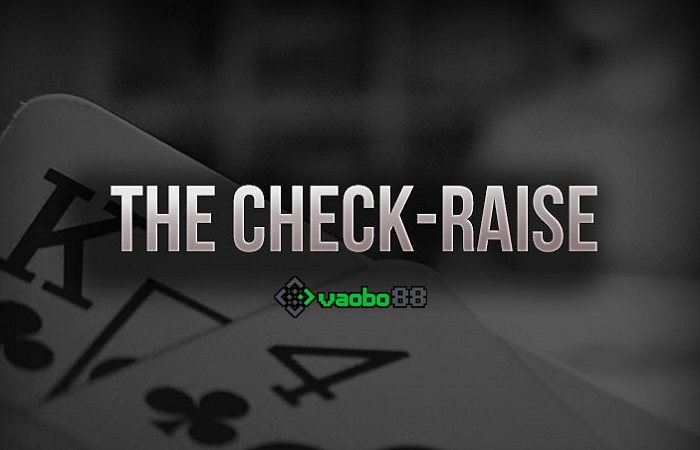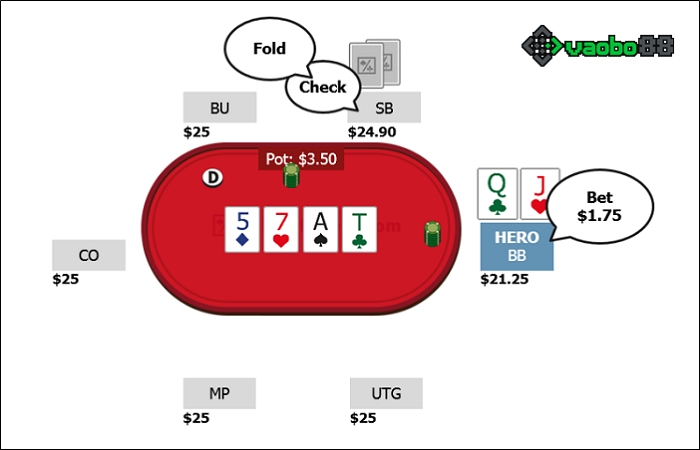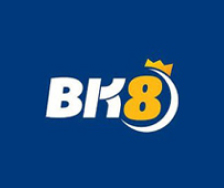What is Check Raise will be answered in detail when you learn about the basic poker terms used in this game.
However, the trick of the Check Raise is much more mysterious and dangerous, causing many players to struggle whenever they fall into it.
To better understand the concept of “taking a step back to move forward” that makes your opponent reluctantly concede, you just need to remember the following information.
What is Check Raise in Poker?
The check command in Poker means that you only check your hand and do not take any additional betting or folding actions.
In fact, checking happens quite frequently, and inexperienced players find it very difficult to predict the thoughts behind this command from their opponents.

A brief overview of the Check Raise strategy
When combining the bet command and the check command, you will have the Check – Raise combination, also known as “taking a step back to move forward.”
This is because players with strong hands only check, causing opponents to become careless, and then immediately Raise back, leaving you unprepared.
There are two trends of action from types of poker players when falling into this situation:
- Players who are timid with low hands will choose to fold immediately to ensure safety – This type is often referred to as Fish in Poker
- Players with strong hands find themselves in a dilemma because they have already made a fairly large bet beforehand.
Why should you Check Raise when playing Poker?
Check Raise is not a trick that beginners can use; therefore, playing in this manner makes you a difficult number to predict at the betting table.
Typically, making a Check Raise not only helps eliminate weak players from the pot but also provides an opportunity to pull in more bets, increasing the prize if you actually have a good hand.
In addition to the reasons above, players can also make a check for the following 4 reasons:
1. Check to control the pot
When you check on the turn, it means that the player is controlling the size of the pot in the match.
For example, if you have a strong hand or a second pair right from the start of the match, it will make the stack very deep while you do not want to play a big pot.
Thus, when betting on the flop, you must skip the bet on the turn and only check to observe the next action on the river.

2. Check to make your opponent bluff on the river
In cases where a player has a strong hand like a set or trips, while the opponent is also very interested in the pot, checking on the turn will be the best choice.
The reason for this is that if you bet at this moment, it will cause weak or medium hands to fold; however, just checking is enough to reveal weaknesses that help you read other opponents while still earning a big pot.
This is a playing direction that allows you to bet on the river if the opponent only checks in the final round. Although it may be a bit dry, it is truly useful as it brings great winning opportunities.
3. Check to trap aggressive players
For aggressive players, seeking opponents with weak hands and unrelated hole cards is quite common.
Therefore, when you place a bet or raise, it signifies showing your strength, while just calling or checking indicates that you are in a weak position in the game.
And of course, when you check, you will make the opponent bet very large into the pot while they do not actually have the advantage.
With this simple playing method, a huge amount of money will flow into the pot, creating opportunities to earn money from Poker.
4. Check if you have a strong hand when a “scary” card appears
Usually, even if you have a strong hand pre-flop or hit the top flop, if the turn brings a dangerous card, the best choice is still to check.
For example, if you have a high pair but the turn shows an Ace, the situation of two pairs or a set can still occur.
Instead of continuing to bet to force weaker hands to fold, you just need to slow down, check lightly to observe their actions.
In a situation where the opponent is also hesitant about raising back, it will be like a ticking time bomb, causing confusion and panic at the table.
Good positions to perform Check Raise
At the betting table in various online Poker rooms, there are quite a few positions with different benefits and betting orders.
If you want to use Check Raise, then observing your own seat and that of your opponents is essential.

Typically, players who are aggressive in Poker will be the first to bet with a light check to allow opponents to calculate and bet more money.
When you are sitting near the end or last, absolutely do not check but rather bet or raise a reasonable amount so that others continue to play.
Suggestions for 2 effective Check Raise methods
There are two most effective ways to use Check Raise for professional Poker players: bluffing or increasing the pot.
Each method requires you to have specific skills as follows:
1. Bluff and Semi Bluff
Bluffing or Semi Bluffing is an effective play when you are in a position that requires you to act early at the table.
Accordingly, you should place a check to give other opponents the opportunity to raise, thereby enhancing the effectiveness of Check Raise, forcing them to fold if they do not have a good hand.
To ensure effectiveness when executing, you should pay attention to the following 3 factors:
Make sure the opponent has a medium hand
Only when you are confident that the opponent does not have good cards and only weak, average hands, can your bluff go in the right direction.
Bet x2 the opponent’s Raise
After checking and successfully luring the opponent to Raise, you need to strongly raise back by 2 times or even more than that amount.
This is said because a mini Raise does not have much impact on the players as they only need to add a small amount of money to call.

Ensure a small pot
When comparing the amount the opponent needs to put in to continue playing with the pot, the pot needs to be ensured to be smaller.
Thus, the remaining players will not be able to call and create opportunities to buy cards, helping your bluff achieve the best results.
In situations where you do not have much money, and the hand you have also needs to be bought, raising only brings risks if the opponent stubbornly calls.
On the other hand, if you are buying cards but the opponent calls, there is still a chance to win the pot if the card you are waiting for appears. Being able to see for free after checking Raise on the flop also creates favorable conditions for you to win.
2. Increase the pot money
Increasing the pot money is also considered a suitable action for players with strong hands to successfully apply the bluff.
Completely different from the previous cases, at this point you do not need to scare the opponent into folding but just need to follow the steps below:
- The more players involved, the larger the pot profit.
- You must sit in the first position.
- You should not check Raise too large but need to allow average hands to follow.
- When playing with the goal of gaining more money, you must ensure your hand is strong enough to beat all other opponents.
What should be noted when performing Check Raise in Poker?
When check Raising, players absolutely cannot be subjective and need to pay attention to the following details:
Your and the opponent’s bankroll range
The opponent’s range needs to be narrowed by the player check Raising right before deciding to make a move.
Specifically, if the flop comes out good for your range, then this is a good opportunity to use the strategy with the hope of bringing about a good enough result.
No need for a very strong hand
Not every time a bluff is needed for the player to have an unbeatable hand.
Even if you only have a medium hand and are waiting for a flush or a straight, you can still apply the trick.
This is also a good way for the opponent to put more money into the pot, thereby increasing the chances of receiving a large reward.
Check the frequency of C bet
The frequency and size of the opponent’s C bet also significantly affect your check Raise range.
Accordingly, when the opponent does not have the habit of C betting much, you need to be particularly cautious.
If the opponent makes a small bet, it indicates that this is a situation with a wide hand range, allowing BB to check Raise more safely.
Conversely, when betting large leads to a polarized range, forcing you to fold or call instead of raising.
Conclusion
After understanding what check in Poker is, using the Check Raise technique will no longer be difficult for players, even for beginners.
It is no coincidence that the Check Raise strategy has received such high praise from the expert community, so do not miss this money-making technique that will astonish your opponents whenever you have the chance.








